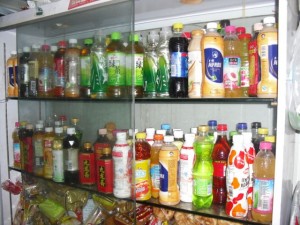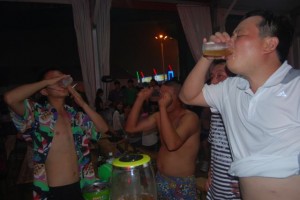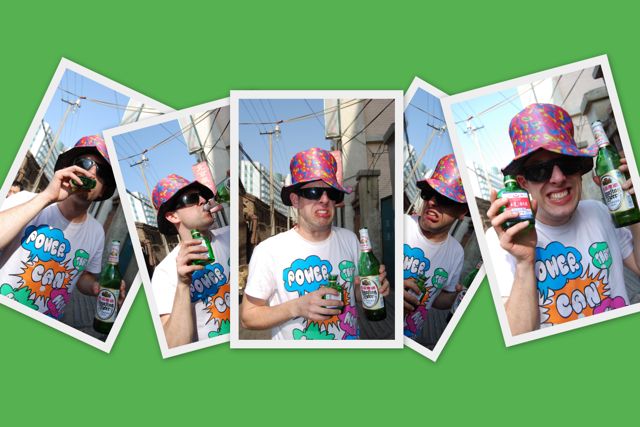Culture Shock in China – Drinking Posted by sasha on May 12, 2013 in Culture, Uncategorized
In case you missed the first installment of our “Culture Shock in China” series, you ought to go back and read about the culture shock associated with food and dining out in China (from an American’s perspective). Of course, you can’t talk about food without talking about drinks. As such, today I’ll share my culture shock experiences when it comes to drinks and drinking in China.
Hot Drinks
People in China love hot drinks. Even when it’s scorching hot in Beijing and I’m dripping sweat in my classroom, my students are filling their bottles with boiling hot water and tea leaves. It’s an ancient Chinese belief that cold drinks are bad for you, and I often get strange looks from colleagues when I reach into the freezer to fill my water bottle with ice cubes in the summer. Thankfully, some people here are catching on to the pleasure of an ice cold beverage in the hot summer months, and many shops and restaurants keep drinks cold during the summer. Don’t expect the same in winter, though, as coolers will be turned off and most drinks will be room temperature.
Choice of Drinks
As an American, I’m used to having milk for breakfast – cold milk, from a cow, in my cereal. That’s not the case here in the Middle Kingdom, where the most popular milk for breakfast is soy milk (豆漿 – dòu jiāng), and it’s usually eaten alongside a hot bowl of porridge and a few steamed stuffed buns. Here in Beijing, a famous snack is mung bean milk (豆汁 – dòu zhī), a sour and funky smelling drink made from the remnants of the mung bean noodle making process.
Of course, the most popular drink across the country is without a doubt tea (茶 – chá); it’s everywhere you look. Green tea, black tea, red tea, iced tea, any kind of tea you want. One drink that you’ll see in just about every Chinese restaurant is Wong Lo Kat (王老吉 – wáng lǎo jí), a kind of herbal tea that is sweet and helps cool you down during a hot pot meal. Check this out if you want to learn the Chinese names for drinks.
A Chinese tea ceremony.
Milk and tea are all well and good, but for the most interesting aspects of drink related culture shock, we need to move on to the hard stuff.
Booze
China loves boozing. You don’t need to go to a bar or club to do some serious drinking here, though. In fact, most Chinese prefer throwing a few back on the street with snacks or in a restaurant. Street beers and street food are probably my two favorite things in China; a big ole’ stick of grilled lamb (羊肉串儿 – yáng ròu chuàn er) and a lukewarm big bottle of Yanjing beer (大瓶燕京啤酒 – dà píng yàn jīng pí jiǔ) go together like spaghetti and meatballs. For some reason, cold beer still hasn’t quite caught on here yet. Either that or restaurant owners and shop-keeps are just too cheap to turn on their coolers. One awesome part about drinking culture in China is that it’s perfectly acceptable to put a few beers down on your lunch break without condescending stares from the other diners.
A highlight video of the 2011 Qingdao Beer Festival.
Drinking beer Chinese style involves constantly refilling a small glass. Cheers is Chinese literally means “dry glass” (干杯 – gān bēi), and that’s exactly what you’re supposed to do when somebody says it. Drinking beer with Chinese men often quickly escalates into a drinking contest, as they’re always pumped up about the possibility of out-drinking a foreigner. Of course, that never happens. Chinese guys tend to turn red after just a few beers, and they get high-school girl drunk if they put down a sixer. Beer is just the warmer, however – the main event comes in the form of Chinese liquor.
Chinese spirits, known as “bai jiu” (白酒 – bái jiǔ – lit. “white liquor”), are made by distilling sorghum. The end product looks like vodka, but the similarities end there. I like to call bai jiu rocket fuel, because you feel like you could take off for the moon after a big sip. At first it doesn’t taste so bad, but then the aftertaste leaves you scrambling to find something anything to help get rid of it. One small sip of the stuff will leave me wincing and squirming, desperately grabbing for a bottle of Coke or some food to destroy the foul taste. Meanwhile, the old Chinese man next to me casually takes a huge gulp, lights up a smoke, and goes about his business as if nothing happened. The idea of chasing booze or using it in a mixed drink is still a very new idea over here; most people just drink the stuff at room temperature, straight, no chaser. Go to a Chinese banquet or wedding, and you will see people getting irresponsibly trashed as they tip glass after glass of bai jiu. If you plan on doing any kind of business in China, you’d better get used to drinking this stuff, as marathon bai jiu drinking is synonymous with meetings and business deals here.
That’s all for today’s installment of “Culture Shock in China.” Stay tuned in the months to come for posts about transportation, relationships, working, and more.

Build vocabulary, practice pronunciation, and more with Transparent Language Online. Available anytime, anywhere, on any device.
About the Author: sasha
Sasha is an English teacher, writer, photographer, and videographer from the great state of Michigan. Upon graduating from Michigan State University, he moved to China and spent 5+ years living, working, studying, and traveling there. He also studied Indonesian Language & Culture in Bali for a year. He and his wife run the travel blog Grateful Gypsies, and they're currently trying the digital nomad lifestyle across Latin America.








Leave a comment: